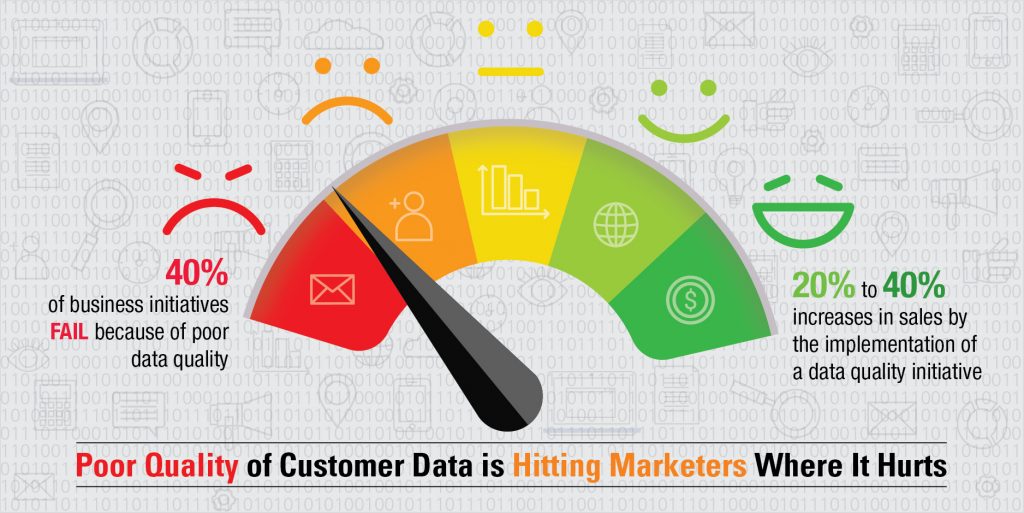
As a sales and marketing division of a leading organization, do you know what the quality of your customer data is? Like other departments, though your division knows that it is something really important and should be managed; as a marketer you try and stay away from it. And it is not your fault completely, either.
Data quality management is considered to be one of the most tedious, manual and exhaustive tasks, hence is ignored. Every year marketers across the world waste millions of dollars because of poor data.
Read through these 6 data quality statistics by Marketing Sherpa, dun & Bradstreet, and Reachforce on how much poor data is hurting not only your sales & marketing efforts, but your entire organization, and you will never ever say “not my responsibility“.
- 40% sales and marketing leads have inaccurate data, 15% contains duplicate records
- 550 hours, 50% employee productivity, and $32,000/- are lost due to bad data
- 25-30% of data decay leads to ineffective sales and marketing campaigns
- With $15 million as the average annual financial cost, 20% revenue loss reported by businesses due to poor data quality
- 16% of companies are confident about the quality of their business data, but 41% companies find it challenging to manage inconsistent data across CRM’s, Marketing Automation Systems etc.
- While you are reading this, 59 address will change, 11 companies will change their name, and 41 new businesses will be registered, and nearly the same amount of companies will close down
Poor data quality erodes customer trust
Imagine the feeling that you get upon receiving an email, addressed to someone else, from the sales and marketing department of some organization.
- Did it affect your perception of the organization which sent you the email?
- Did you not think, whether the sales and marketing team even makes efforts to validate the data before shooting an email?
- Will you not think, this organization does not believe in basic customer data cleansing?
- How do such companies survive while using invalid data or unclean data is what you will strongly feel?
- Why can’t such organizations immediately take up data cleansing, and take care of missing and incomplete data?
- The enterprise should immediately strategize to improve customer data quality, starting with data preparation & data auditing – is what you will strongly feel.
If a customer does not trust you for the information that you as an organization have about them, the overall confidence they have in your establishment erodes, and erodes really fast. Correlate the above scenario with your organizational data.
Companies like AirBnB, Amazon, eBay, MailChimp and many more, are using good quality data to know who actually their customers are, where they are, and what they like. In such a scenario can you afford to operate with bad data or dirty data?
You as an organization are not only taking a financial hit, dirty data is denting your digital initiatives and spreading customer distrust too. Poor data quality weakens your organization’s competitive standing and continuously discourages critical business objectives. If you still don’t understand the implications of poor data and importance of quality data in business, you are doing yourself, and your company, a great damage.
Good quality business data is known to empower businesses, across industries, with insights and start new business models. And for this, organizations can first improve and then strengthen the quality of business data with the help of enlisted best practices:
1. Measure financial cost of poor quality data
Approximately 60% of organizations either are not able to, or are unaware of the fact that they should measure the financial cost of poor quality data. Failure to measure this impact has ripple effects in form of data quality issues, missed business growth opportunities, increased risks and consistently decreasing ROI.
Proactively measuring the value of information assets, and assessing the cost of poor quality data Vs the value of good quality data, can bring you in the league of information-driven organizations. Now you can link these aspects directly to key business performance metrics, too.
2. Data scientists or data analysts
Companies are not yet up and running with qualified data professionals onboard, even are not sure of whether to hire a data scientist or a data analyst; and hence lack the most essential data quality roles. Unfortunately, even if an organization has a few of the data scientists or analysts, they don’t know where to place them for optimal impact. Eventually this gap becomes the reason for fading out effectiveness of data quality initiatives.
Chief data officers – CDOs struggling to meet data quality objectives should establish data professionals to manage data quality, including data stewards and scientists, visualizers, analysts and many more. One more reason why CDOs should be doing it is that these roles and responsibilities have started shifting from IT departments. It is an indication that information management is maturing, and data quality is being recognized as a cross organizational collaboration.
3. Cost effective data quality tools
Businesses at times opt for tools that they think are agile, but ideally are not cost effective. This results in distrust between data quality execution teams and management. Enterprises end up spending $208,000 on the upper end, and on an average $150,000 for on-premises data quality tools. The cost is really high and also a barrier to adoption of more pervasive tools. There are numerous techniques that can be leveraged to make data quality tools – more cost effective and option.
One of the most important and proven methodology is of adopting the offshore or outsourcing data cleansing approach. It has proved its worth as one of the best options to drive high business value and manage data fit for governance purpose.
Final word
Data validation and data enrichment are the intensive need for organizations these days. Organizations possessing large data sets have realized that it is of no use to them, if it contains incorrect or inaccurate information. This makes it all the more important for you as a customer centric companies to not only have data quality tools or data quality personnel onboard, but to see that they are cost effective too.
Businesses need data specialists to format, classify, modify, replace, organize, delete and correct collected customer information across multiple data fields.



